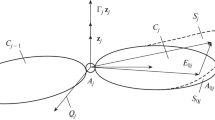Abstract—
Relevant problems on modeling mechanisms with elastic links imply the improvement of existing formalisms and algorithms for dynamic analysis, synthesis, and optimal control of the considered class of systems. At the same time, modern research in this area is mainly focused on increasing the speed of computational algorithms without decreasing in the accuracy. If elastic multi-link dynamical systems that do not include closed kinematic chains can be comprehensively investigated using the approach without inversion of the mass matrix (generalized Newton-Euler method), then elastic mechanisms with closed kinematic chains should be studied using the methods with inversion of the mass matrix. The latter class includes the problem on finding the conditional minimum of the action functional in the sense of Ostrogradsky in the presence of holonomic (geometric) additional constraints. In this article, we analyze the problem on optimizing the motion of an elastic three-link tracking manipulator that consists in minimizing the function of deviation of the actuator from a predetermined circumferential trajectory. This problem is also reduced to finding the conditional minimum of the Ostrogradsky action functional in the presence of a holonomic additional constraint.
Similar content being viewed by others
REFERENCES
M. Pascal and T. Gagarina, “A pseudo-rigid model for the dynamical simulation of flexible mechanisms,” Multibody Syst. Dyn. 3, 303–331 (1999).
M. Gofron and A. A. Shabana, “Control structure interaction in the nonlinear analysis of flexible mechanical systems,” Int. J. Nonlin. Dyn. 4, 183–206 (1993).
J. Y. S. Luh, M.W. Walker, and R. Paul “On-line computational scheme for mechanical manipulators,” Trans. ASME J. Dyn. Syst. Meas. Contr. 74, 251–269 (1980).
R. Featherstone, “The calculation of robot dynamics using articulated-body inertias,” Int. J. Robot. Res. 2 (1), 13–30 (1983).
E. Dombre and W. Khalil, Modélisation et Commande des Robots (Hermès, 1988).
E. Dombre and W. Khalil, Modélisation, Identification et Commande des Robots (Hermès, 1999).
O. Verlinden, “Simulation du Comportement Dynamique de Systemes Multicorps Flexibles Comportant des Membrures de Forme Complexe,” Doctoral Thesis (Polytechnic Faculty of Mons, 1994).
P. Fisette, J.-C. Samin, “Symbolic generation of large multibody system dynamic equations using a new semi-explicite Newton-Euler recursive scheme,” Arch. Appl. Mech. 66, 187–199 (1996).
F. Boyer and P. Coiffet, “Generalization of Newton-Euler model for flexible manipulators,” Int. J. Robot. Syst. 13 (1), 11–24 (1996).
F. Boyer and P. Coiffet, “Symbolic modeling of a flexible manipulator via assembling of its generalized Newton-Euler model,” Int. J. Mech. Mach. Theory 31 (1), 45–56 (1996).
F. Boyer and W. Khalil, ”An efficient calculation of flexible manipulators inverse dynamics,” Int. J. Robot. Res. 17 (3), 282–293 (1998).
Yu. L. Sargsyan, K. G. Stepanyan, N. Azuz, and H. A. Gevorgyan, “Dynamic analysis of flexible manipulators using the generalized Newton-Euler method,” Izv. NAN RA GIUA. Ser. TN 57 (1), 3–10 (2004).
Yu. L. Sargsyan, K. G. Stepanyan, and H. A. Gevorgyan, “Dynamic analysis of flexible tree-like mechanical systems without external constraints,” Izv. NAN RA GIUA. Ser. TN 59 (1), 3–9 (2006).
H. A. Gevorkian, “Dynamic analysis of elastic tree-like mechanical systems in the presence of external holonomic bonds,” Inf. Technol. Manag., No. 4, 36–43 (2004).
H. A. Gevorkian, “Dynamic modeling of mechanisms with elastic links of variable length,” Vestn. GIUA Ser. Mekh. Mashinoved. Mashinostr., No. 2, 34–41 (2014).
H. A. Gevorgyan, “An application of the generalized Newton-Euler method in the optimal control problems of flexible mechanisms,” Izv. NAN RA GIUA. Ser. TN 63 (2), 133–138 (2010).
H. A. Gevorgyan, “About one modification of manipulators dynamical analysis with inversion of its mass matrix,” in Proceedings of V International Conference “Topical Problems of Continuum Mechanics,” 2-7 Oktober 2017, Tsakhkadzor, Armenia (Yerevan, 2017), pp. 61–62.
H. A. Gevorgyan, “The dynamic analysis of the parallel link mechanism with an elastic rod,” in Proceedings of VIII International Conference “The Problems of Dynamics of Interaction of Deformable Media,” September 22–26, 2014, Goris-Stepanakert, Armenia (Yerevan, 2014), pp. 143–147.
Author information
Authors and Affiliations
Corresponding author
Additional information
Translated by A.A. Borimova
About this article
Cite this article
Gevorgyan, H.A. PROBLEM ON OPTIMIZING THE MOTION OF AN ELASTIC TRACKING MANIPULATOR. Mech. Solids 56, 242–249 (2021). https://doi.org/10.3103/S0025654421020072
Received:
Revised:
Accepted:
Published:
Issue Date:
DOI: https://doi.org/10.3103/S0025654421020072




